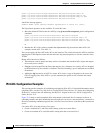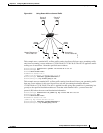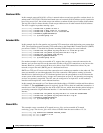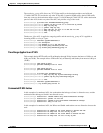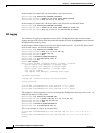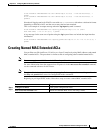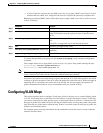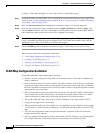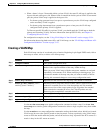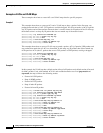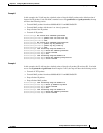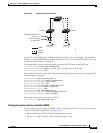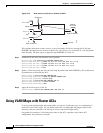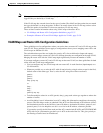
33-30
Catalyst 3560 Switch Software Configuration Guide
OL-8553-06
Chapter 33 Configuring Network Security with ACLs
Configuring VLAN Maps
To create a VLAN map and apply it to one or more VLANs, perform these steps:
Step 1 Create the standard or extended IPv4 ACLs or named MAC extended ACLs that you want to apply to the
VLAN. See the
“Creating Standard and Extended IPv4 ACLs” section on page 33-7 and the “Creating a
VLAN Map” section on page 33-31.
Step 2 Enter the vlan access-map global configuration command to create a VLAN ACL map entry.
Step 3 In access-map configuration mode, optionally enter an action—forward (the default) or drop—and
enter the match command to specify an IP packet or a non-IP packet (with only a known MAC address)
and to match the packet against one or more ACLs (standard or extended).
Note If the VLAN map is configured with a match clause for a type of packet (IP or MAC) and the map action
is drop, all packets that match the type are dropped. If the VLAN map has no match clause, and the
configured action is drop, all IP and Layer 2 packets are dropped.
Step 4 Use the vlan filter global configuration command to apply a VLAN map to one or more VLANs.
These sections contain this configuration information:
• VLAN Map Configuration Guidelines, page 33-30
• Creating a VLAN Map, page 33-31
• Applying a VLAN Map to a VLAN, page 33-34
• Using VLAN Maps in Your Network, page 33-34
VLAN Map Configuration Guidelines
Follow these guidelines when configuring VLAN maps:
• If there is no ACL configured to deny traffic on an interface and no VLAN map is configured, all
traffic is permitted.
• Each VLAN map consists of a series of entries. The order of entries in an VLAN map is important.
A packet that comes into the switch is tested against the first entry in the VLAN map. If it matches,
the action specified for that part of the VLAN map is taken. If there is no match, the packet is tested
against the next entry in the map.
• If the VLAN map has at least one match clause for the type of packet (IP or MAC) and the packet
does not match any of these match clauses, the default is to drop the packet. If there is no match
clause for that type of packet in the VLAN map, the default is to forward the packet.
• The system might take longer to boot up if you have configured a very large number of ACLs.
• Logging is not supported for VLAN maps.
• When a switch has an IP access list or MAC access list applied to a Layer 2 interface, and you apply
a VLAN map to a VLAN that the port belongs to, the port ACL takes precedence over the VLAN
map.
• If VLAN map configuration cannot be applied in hardware, all packets in that VLAN must be
bridged and routed by software.
• You can configure VLAN maps on primary and secondary VLANs. However, we recommend that
you configure the same VLAN maps on private-VLAN primary and secondary VLANs.



